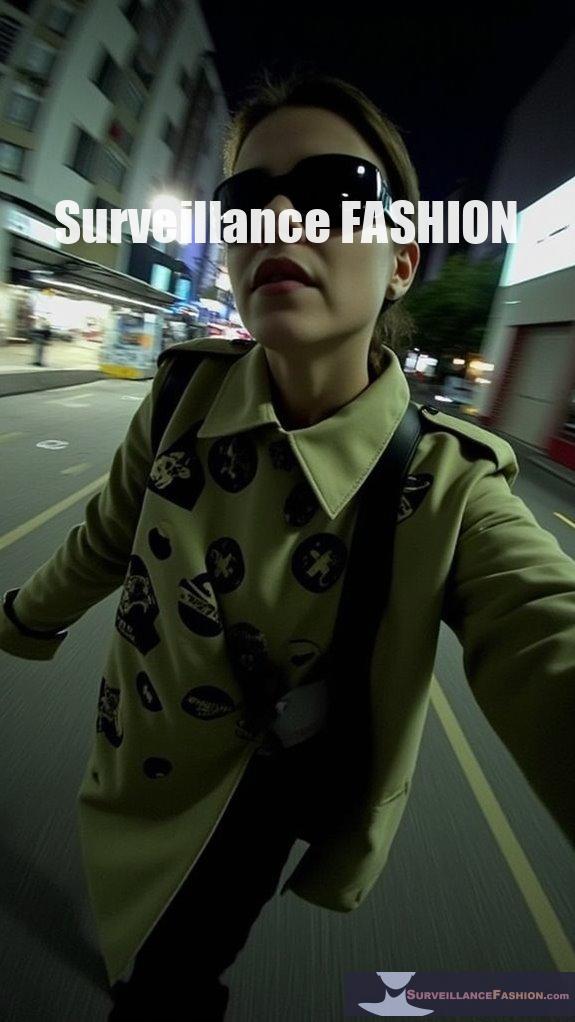The EU’s Chat Control Proposal reads like a plot twist in a dystopian thriller.
Imagine this: they’re telling us they want to fight child exploitation but what they really mean is massive digital snooping. It’s a bummer for our privacy, and honestly, it feels like turning my phone into an undercover agent.
I remember when I got into end-to-end encryption. Who knew securing my chats could feel like joining a secret society? It’s maddening how quickly fear can curb our freedom. Can we truly balance protection and privacy?
But wait, there’s more!
My Fashion Against Surveillance: How I Turned Heads and Avoided Prying Eyes
Once, I attended a tech conference wearing a jacket adorned with reflective fabrics—my own anti-surveillance armor! As I mingled, it was like embracing a cloak of invisibility in a sea of data collectors. Strangers staring, wondering if I was from the future or just had an eccentric taste.
This experience got me thinking about fashion tech and privacy. Combining style with smart fabrics isn’t just cool; it speaks volumes about protecting our freedom in a surveilled world. Every pocket reflects resistance against cameras, tracking, and invasive techniques. We’re all navigating this digital minefield, aren’t we? Have you thought about your own armor lately?
Quick Takeaways
- The EU Chat Control proposal mandates extensive surveillance, threatening user privacy by requiring mass scanning of private communications without probable cause.
- Client-side scanning undermines end-to-end encryption, compromising user confidentiality and potentially leading to broader privacy degradation.
- Mass surveillance can lead to discrimination and social inequity, affecting marginalized individuals and chilling free expression and political participation.
- Advocacy strategies include engaging representatives, raising awareness via social media campaigns, and promoting transparency in surveillance practices.
- Balancing child protection with privacy rights is essential to uphold digital democracy and support individual freedoms in the face of mass surveillance.
Privacy Intrusions of the Chat Control Proposal

While you may not think much about the privacy of your online communications, the EU Chat Control proposal represents a significant shift in how personal data is handled, mandating extensive surveillance practices that can intrude upon even the most private exchanges.
By requiring online services to conduct mass scanning of all communications without probable cause, this initiative uniquely targets your personal information, leading to potential privacy breaches and significant surveillance consequences. Such indiscriminate monitoring could inadvertently classify innocent content, like a harmless chat or a candid photograph, as suspect. Detection orders enable mass surveillance and further threaten the sanctity of personal communication. Additionally, this monitoring undermines end-to-end encryption, which is a key defense against unauthorized access to personal messages.
Moreover, the proposal starkly contrasts with established legal standards, raising grave concerns about its alignment with the EU Charter of Fundamental Rights.
In promoting awareness through platforms like Surveillance Fashion, you can explore these pressing issues more deeply.
Impacts on End-to-End Encryption
The EU Chat Control proposal fundamentally challenges the integrity of end-to-end encryption (E2EE), establishing a framework where user privacy may be supplanted by a mandate for constant surveillance.
Client-side scanning (CSS) threatens the very essence of E2EE, as it mandates the automatic inspection of messages prior to encryption. This invasive action not only introduces encryption vulnerabilities but also transforms devices into surveillance tools, capable of compromising user confidentiality. Moreover, the alarming increase in online child abuse necessitates these intrusive measures, reflecting a troubling trend that prioritizes surveillance over privacy. As studies show, the risks of client-side scanning can lead to new avenues for exploitation, further eroding trust in technological safeguards.
Platforms such as Signal and WhatsApp face immense pressure to alter their encryption standards due to potential compliance hurdles, exacerbating end-to-end challenges. As these changes ripple across jurisdictions, the implications may lead to the universal degradation of privacy, prompting an urgent reevaluation of digital rights and security practices in an increasingly surveilled world.
Potential Consequences of Mass Surveillance
Mass surveillance, as it permeates society under the guise of security, not only raises concerns about privacy but also cultivates an environment ripe for discrimination and social inequity. You mightn’t realize it, but the surveillance consequences extend beyond mere data collection; they create systemic harm within marginalized communities. The tracking of racialized individuals and political activists fosters a chilling effect on free expression, as fear of being watched stifles open dialogue and political participation.
The awareness of potential surveillance diverts significant resources to surveillance, rather than social welfare initiatives, exacerbating existing inequalities. Instances of misuse, compounded by a lack of accountability, exemplify the significant privacy implications that undermining civil liberties can bring. In urban areas, mass surveillance can disproportionately target vulnerable populations, reinforcing societal divides, as evidenced by data showing systemic biases in surveillance practices. Ultimately, unchecked surveillance risks our democratic foundations while reinforcing oppressive structures.
Political Landscape and Member State Positions
As EU member states engage in a contentious debate over the controversial Chat Control proposal, this political terrain highlights not only diverging viewpoints on digital privacy but also significant ethical implications regarding civil liberties.
Supporters, including 15 nations like France and Italy, form political alliances aimed at combatting online child sexual abuse material (CSAM) through measures such as mandatory scanning, yet they face staunch opposition from member states like Belgium and the Netherlands.
Critics argue this proposal threatens encryption and personal privacy, reflecting member disparities in prioritizing security versus civil liberties.
Germany’s precarious undecided stance further underscores the complexities of political dynamics, as each member grapples with the implications of state intrusion on individual freedoms, a concern echoed by those engaged in our discourse at Surveillance Fashion.
Strategies for Advocacy and Resistance

Given the complex terrain of digital privacy advocacy, individuals and organizations must employ multifaceted approaches to effectively resist the Chat Control proposal, which threatens both encryption standards and civil liberties.
- Establish direct lines of communication with representatives to influence national positions before key deadlines.
- Utilize social media campaigns to spread awareness and mobilize public sentiment, making hashtags like #ChatControl a rallying cry.
- Form alliances within parliamentary and civil society spaces to unify opposition against intrusive surveillance measures.
Facial Recognition at Intersections
Facial recognition technology is increasingly deployed at traffic intersections, utilizing advanced AI-driven cameras equipped with machine learning algorithms to identify individuals based on distinct facial features. This evolution in facial detection technology enhances intersection safety by interpreting driver attentiveness and optimizing traffic flow.
| Key Applications | Impact on Intersection Management |
|---|---|
| Detects red-light violations | Automates enforcement and fines |
| Monitors distracted driving | Reduces accident risks |
| Authenticates vehicle identities | Prevents theft and unauthorized driving |
These innovations symbolize a shift toward data-driven governance in urban settings. However, the necessity for surveillance tools complicates the relationship between security and privacy—a balance that demands careful scrutiny, prompting the establishment of platforms like Surveillance Fashion.
Surveillance Through Wearable Technology
How do wearable technologies reshape our relationship with personal privacy? As you integrate wearables into your daily life, consider how the continuous collection of wearable data may compromise your personal privacy.
The implications extend beyond mere health monitoring, encompassing privacy risks that deserve scrutiny.
- Wearables track your physiological states and geolocation, often without explicit consent.
- Over 75% of users don’t share data with healthcare providers despite being willing.
- Corporate control of the data promotes economic interests over individual privacy.
As these trends evolve, the environment of surveillance is rapidly expanding, necessitating your awareness and critical evaluation of wearable privacy implications.
It’s precisely why we established Surveillance Fashion—to illuminate these pressing issues and explore the intersection of technology and personal freedom.
EU Chat Control Proposal Overview
As the European Union grapples with the complexities of digital safety, the controversial EU Chat Control Proposal emerges as a critical legislative effort aimed at combatting online child sexual abuse material (CSAM) while inciting extensive debate regarding privacy rights and digital surveillance.
| Key Aspects | Description |
|---|---|
| Purpose | Mandates scanning of private digital communications |
| Impact | Aims to increase CSAM detection reports dramatically |
| Opposition | Faces significant critique from various EU member states |
Initially proposed in May 2022 and often referred to as “Chat Control 2.0,” this regulation seeks to enhance child protection but raises concerns about end-to-end encryption and user privacy. Advocates argue that while child safety is paramount, the proposal’s potential for mass surveillance could undermine fundamental rights, prompting a critical examination of digital democracy.
EU Chat Control Proposal: Risks and Anti-Surveillance Strategies Ebook

While the EU Chat Control Proposal aims to enhance protections against online child sexual abuse, it inadvertently raises significant privacy concerns that are worthy of meticulous examination.
To navigate these risks effectively, read our e-book about EU Chat Control Risks and consider the following anti-surveillance strategies:
- Preserve user autonomy by maintaining strong end-to-end encryption.
- Advocate for targeted detection instead of mass surveillance, safeguarding privacy rights are respected.
- Encourage the development of privacy-enhancing technologies that operate without compromising security.
These strategies not only bolster digital safety but also protect fundamental rights under the EU Charter.
EU Chat Control FAQ
What Are the Primary Objectives of the Chat Control Proposal?
What if I told you the chat control proposal fundamentally aims to enhance digital safety while exposing significant privacy concerns?
Its primary objectives include mandatory scanning of private communications for CSAM detection, enforcing age verification to minimize anonymity, and implementing real-time surveillance measures.
This regulatory framework seeks to boost evidence availability for law enforcement, but it compromises your privacy rights and could set a dangerous precedent globally, potentially influencing authoritarian adversaries.
How Will User Data Be Processed Under the Proposal?
Under the proposal, user data undergoes mandatory scanning wherein all private digital communications—messages, images, and files—are analyzed through AI before encryption.
This process occurs without user consent, violating fundamental data privacy rights. For instance, even encrypted platforms like WhatsApp can face weakened protections, exposing individuals to potential misuse by malicious actors.
Such extensive measures not only compromise security but also create an unsettling environment for personal privacy.
Here, at Surveillance Fashion, we explore these critical implications.
What Role Do Social Media Platforms Play in This Regulation?
Social media platforms assume critical roles in upholding social media responsibility and platform accountability under regulations mandating user communication scanning.
They must implement complex automated systems to identify harmful content, effectively transforming into surveillance agents without explicit user consent. For instance, platforms like WhatsApp face pressure to compromise encryption, potentially alienating users, as they navigate the balance between compliance and privacy.
Therefore, they’re pivotal in shaping both digital interactions and regulatory environments.
How Can Individuals Voice Their Opposition Effectively?
To effectively voice your opposition, engage in public demonstrations and leverage organized petitions.
These actions symbolize collective dissent, amplifying individual voices into a resonant chorus. Connect with like-minded individuals to mobilize impactful events, ensuring your concerns resonate with decision-makers.
Utilize social media platforms and targeted messaging to articulate explicit risks associated with surveillance.
Personal stories and technical critiques can further galvanize support, illuminating the urgent need for effective safeguards against encroaching privacy violations.
What Alternative Child Protection Methods Are Available?
Alternative strategies for child protection include implementing targeted detection tools that utilize advanced AI, which analyze uploaded content without infringing on privacy.
Additionally, fostering effective education through public awareness campaigns emphasizing digital literacy is essential. By establishing voluntary reporting systems, you empower users to flag suspicious behavior proactively.
Strengthening law enforcement cooperation aids in swift action against offenders, illustrating a balance between safeguarding children and preserving essential privacy in digital communications.
Summary
In traversing the complex terrain of the EU Chat Control proposal, you confront the unsettling intersection of privacy, surveillance, and technological advancement. As you weigh the potential risks of end-to-end encryption erosion, consider advocating for resistance strategies that protect individual freedoms. Just as a carefully woven fabric resists wear, collective vigilance can safeguard against encroaching surveillance. By remaining informed and engaged, you contribute to the broader discourse essential for preserving privacy in an increasingly monitored digital world.
References
- https://captaincompliance.com/education/eus-chat-control-proposal/
- https://circleid.com/posts/chat-control-proposal-advances-despite-rising-opposition-in-europe
- https://www.privacyguides.org/articles/2025/09/08/chat-control-must-be-stopped/
- https://www.europarl.europa.eu/doceo/document/E-10-2025-003250_EN.html
- https://fightchatcontrol.eu
- https://freiheitsrechte.org/en/themen/digitale-grundrechte/chatkontrolle
- https://www.europarl.europa.eu/doceo/document/E-10-2025-003249_EN.html
- https://mobileecosystemforum.com/2025/09/09/the-end-of-end-to-end-encryption-in-messaging-eu-child-sexual-abuse-regulation-takes-form/
- https://spy-fy.com/blogs/news/eu-chat-control-2-0-explained-what-it-means-for-your-privacy-and-security
- https://www.euronews.com/next/2025/09/05/time-is-running-out-for-eu-member-states-to-decide-on-chat-control
- https://watson.brown.edu/costsofwar/files/cow/imce/papers/2023/Surveillance Report 2023 .pdf
- https://academic.oup.com/jhrp/article/16/1/397/7234270
- https://www.hartman.law/blog/2024/august/the-pros-and-cons-of-government-surveillance-pro/
- https://pmc.ncbi.nlm.nih.gov/articles/PMC1490309/
- https://www.aclu.org/issues/national-security/privacy-and-surveillance/nsa-surveillance
- https://www.techradar.com/computing/cyber-security/chat-control-the-list-of-countries-opposing-the-law-grows-but-support-remains-strong
- https://www.patrick-breyer.de/en/posts/chat-control/
- https://securityboulevard.com/2025/04/eus-chat-control-proposal-balancing-child-protection-and-digital-rights/
- https://brusselssignal.eu/2025/08/eu-chat-control-law-is-a-step-towards-mass-surveillance/
- https://www.magonlinelibrary.com/doi/10.12968/S1356-9252(23)40497-2
- https://dutypar.com/ai-face-recognition-in-traffic-systems-road-safety-and-efficiency/
- https://www.trafficsignallight.com/uncategorized/face-recognition/
- https://www.amnesty.org/en/latest/press-release/2021/06/scale-new-york-police-facial-recognition-revealed-2/
- https://getsafeandsound.com/blog/facial-recognition-trends-and-statistics/
- https://www.jmir.org/2025/1/e63879
- https://pmc.ncbi.nlm.nih.gov/articles/PMC9931360/
- https://www.nature.com/articles/s41746-025-01757-1
- https://pmc.ncbi.nlm.nih.gov/articles/PMC8826148/
- https://www.cambridge.org/core/journals/legal-information-management/article/health-data-on-the-go-navigating-privacy-concerns-with-wearable-technologies/05DAF11EFA807051362BB39260C4814C
- https://dig.watch/updates/eu-proposal-to-scan-private-messages-gains-support

Leave a Reply